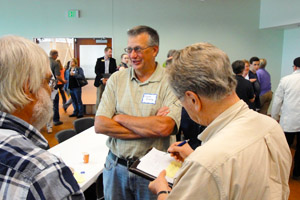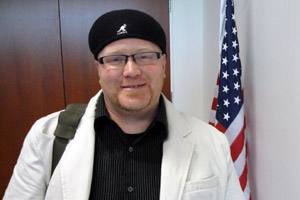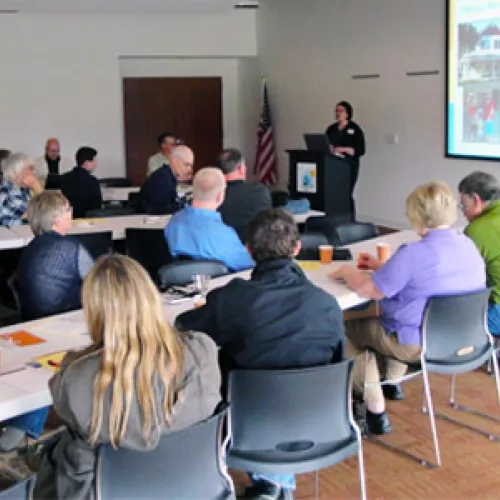Tuesday, May 21, 2013, the Southeast Clean Energy Team (SE CERT) held an event highlighting four past seed grant recipients and their projects. The goal of the event was to get to know a little more about their experiences, what kind of lessons they learned, and what connections they made. It was also an opportunity for the community to learn about local projects, about the SE CERT seed grant process, and to make connections with others enthusiastic about energy. This event took place at Cascade Meadow Wetlands & Environmental Science Center in Rochester, Minnesota.
Project 1: White Water Garden Farms
 Lonny Dietz, co-owner of Whitewater Garden Farms, was awarded a SE CERT seed grant in 2008. During the forum, he spoke about the construction of a two-bay greenhouse with cold storage, which he and his wife Sandy use to grow tomatoes, green beans, ginger, cucumbers, and lettuce through the winter. They have completed three seasons of growth and are really starting to understand the intricacies of their system and what plants do well in extended growing seasons.
Lonny Dietz, co-owner of Whitewater Garden Farms, was awarded a SE CERT seed grant in 2008. During the forum, he spoke about the construction of a two-bay greenhouse with cold storage, which he and his wife Sandy use to grow tomatoes, green beans, ginger, cucumbers, and lettuce through the winter. They have completed three seasons of growth and are really starting to understand the intricacies of their system and what plants do well in extended growing seasons.
The project began with a large hole, in which they laid their loop field. Each bay of the greenhouse had nine loops, covered by 12-14 inches of soil, allowing the temperatures of the top soil to be 60 degrees and the ambient temperature to get up to 78 degrees the first winter. A cold storage facility was built with Structurally Insulated Panels (SIP) from Cottonwood, MN, eight inches wide for the walls and ten inches for the roof. They built three zones, including a cold storage site and processing area, using water storage tanks as a thermal sink so that they could control each zone separately. They ended up needing to install fans to control humidity in the cold storage room, keeping it at 39 degrees all summer with just geothermal. The greenhouse itself was built in an especially snowy, icy winter, using Econar system from Elk River and Polytex from Cannon Falls. It was important to the Dietz’s to try and source most of the products they used locally.
Lonny expressed to the group that he wished he had had more information on similar projects before they had started their greenhouse. He felt like he could have greatly benefited from talking to others that had completed greenhouses and grant processes similar to his. That’s one of the benefits Lonny sees to the CERTs process and the case studies that are produced about each project. He’s received a number of calls over the past few years from others looking at their own projects and coming to Lonny for advice.
The Deitz’s also had challenges with funding and knowing all the rules for grants, ultimately missing out on some major funding opportunities. While the greenhouse has been through three seasons, it is still a work in progress. Lonny and Sandy have learned which plants thrive in the greenhouse, while some, like the tomatoes, struggle with the soil temperatures and new insect pests that make their home in the warmth. In addition, they expected geothermal to take care of the greenhouse’s heating needs in temperatures down to 20 degrees, but found that they system is really only effective down to 40-50 degrees. They are now using propane to help compensate for the lack of heat, which is costing them quite a bit of money. In the future, they want to update their boiler system and include LED lighting.
Project 2: Minnesota Student Energy Project
 The second group to present was a group of students from Mayo High School, who are part of the Minnesota Student Energy Project (MNSEP). Colin Weinshenker, Liam Hathaway and Meredith Jett, who have leading positions in MNSEP, presented on the success of what was originally coined, the Olmstead County Solar Initiative. The program began in 2008 when three Mayo High School students wanted to see solar on their school. They were originally discouraged from pursuing the project due to high cost, but believing in the generosity of others, the students continued on with their dream and started fundraising, not really knowing how much they needed. Within a year of starting this quest, they raised $140,000 and installed a 5.8kW photovoltaic (PV) system on Mayo High School’s roof.
The second group to present was a group of students from Mayo High School, who are part of the Minnesota Student Energy Project (MNSEP). Colin Weinshenker, Liam Hathaway and Meredith Jett, who have leading positions in MNSEP, presented on the success of what was originally coined, the Olmstead County Solar Initiative. The program began in 2008 when three Mayo High School students wanted to see solar on their school. They were originally discouraged from pursuing the project due to high cost, but believing in the generosity of others, the students continued on with their dream and started fundraising, not really knowing how much they needed. Within a year of starting this quest, they raised $140,000 and installed a 5.8kW photovoltaic (PV) system on Mayo High School’s roof.
The students who began this journey appealed to their peers, asking for donations, hosting a “power week” to raise money through dances, fine arts shows, and student memberships, and asking them to spread the word through the rest of the community. With more support from area businesses and a $75,000 grant from the American Public Power System, the students were not only able to fund the solar electric system on Mayo High School, but will also have solar panels on every high school in Rochester by the end of this summer. Their desire to continue exposing students to solar, which they call Edu-Carbon, is based on education and carbon. They want to educate students about the importance of a future with renewable energy and show them examples that cut CO2 emissions, such as their PV panels. In addition to the very visible panels, there are also displays in the atrium of Mayo High School and energy-based classroom work using data from the system.
Based on their success in Rochester, MNSEP is now working to help students from other schools in Minnesota adopt similar projects. They have worked with Cretin Durham Hall students in St. Paul and a solar system will be going up in the near future on their school. They are looking to connect with more schools and spread the word that just a few students can make a big impact in the community. All this hard work has not gone unnoticed. Mayor Brede of Rochester and former Governor Pawlenty have both given their congratulatory remarks to the group, and the American Fundraising Professionals recognized them in 2009 with the Outstanding Fundraising Award.
Colin Weinshenker’s presentation focused on what the team had learned and where they’d faced their biggest challenges. They’ve learned a lot about what it means to be sustainable. While the solar system they have will keep producing for quite some time and is now a symbol for the community, they need to make sure that they keep the interest alive among the student population to keep growing and expanding. Dealing with an ever-revolving group of students, Colin expressed the need to put some effort and enthusiasm into continually recruiting students so that the work continues.
Project 3: Minnesota Renewable Energy Society’s Solar Thermal Bulk Buy
 The third group to present was the Minnesota Renewable Energy Society (MRES), who had a two-stage project in 2012 focused on solar thermal technologies. Dustin Denison and Jim Dontje, both MRES Board Members, co-presented about the MRES bulk buy project and lessons learned. Phase 1 of the project launched in the Metro and connected consumers with bulk buy plans to purchase either Solar Skies or Velux panels while working with one of six participating contractors.
The third group to present was the Minnesota Renewable Energy Society (MRES), who had a two-stage project in 2012 focused on solar thermal technologies. Dustin Denison and Jim Dontje, both MRES Board Members, co-presented about the MRES bulk buy project and lessons learned. Phase 1 of the project launched in the Metro and connected consumers with bulk buy plans to purchase either Solar Skies or Velux panels while working with one of six participating contractors.
For the second phase of the project, MRES focused on expanding the program into southeastern Minnesota. They understood that areas with electric heating and propane might be good targets for looking at solar thermal technologies and aimed to target those end users. As this project was spread out across a region, rather than focused in one city, if faced a different set of challenges. MRES struggled to find contractors that were willing to travel, but eventually found one that would do the work. In addition, because the CERTs seed grants cover only labor, they realized they didn’t have enough time or money to spend on marketing. They also faced challenges with different permitting and zoning requirements within each local jurisdiction across the region. These “soft costs” associated with installations, such as plumbing or permitting issues, added up quickly and got in the way of being able to provide a single uniform standard installation that one would typically look for in a bulk buy plan.
While they did have a number of issues standing in the way of total success, they learned a number of valuable lessons that others can take away. Not only about the importance of marketing and budgeting enough money to allow yourself to reach your audience, but, as Jim Dontje stressed, the importance of how you frame energy projects. While many people want to hear about a return on investment, it is important to remember that we are all going to be spending money on energy regardless. The idea, Jim told the group, is that when you invest in renewable energy projects, you will be paying for cheaper and cleaner energy by paying for it up front. You won’t have to worry about rising costs of energy and can have comfort in knowing where the energy you are heating your home with is coming from!
Project 4: Three Rivers Community Action’s Home Matters
 Jenny Larson, from Three Rivers Community Action, was the final presenter at the forum. She spoke about the two projects that CERTs has helped to fund. The first project, which was called Home Matters, took place in 2009 and focused on foreclosed properties in Northfield. Three Rivers wanted to do something to address the growing number of foreclosures to help stabilize neighborhoods and demonstrate best practices for home renovation. Three Rivers focused on a number of factors, including energy efficiency and health (including lead and radon testing). Together with the Housing Redevelopment Authority (HRA) and RENew Northfield, their goal was to share knowledge with the community about measures they could take. The project had two pieces, the first to acquire and renovate homes, and the second was to create a down payment assistance program.
Jenny Larson, from Three Rivers Community Action, was the final presenter at the forum. She spoke about the two projects that CERTs has helped to fund. The first project, which was called Home Matters, took place in 2009 and focused on foreclosed properties in Northfield. Three Rivers wanted to do something to address the growing number of foreclosures to help stabilize neighborhoods and demonstrate best practices for home renovation. Three Rivers focused on a number of factors, including energy efficiency and health (including lead and radon testing). Together with the Housing Redevelopment Authority (HRA) and RENew Northfield, their goal was to share knowledge with the community about measures they could take. The project had two pieces, the first to acquire and renovate homes, and the second was to create a down payment assistance program.
Home Matters worked on four properties, focusing on energy conservation, water conservation, low volatile organic compounds (VOCs), and other changes that were necessary for the individual situations of the homes. They paid a lot of attention to the heating, ventilation and air conditioning (HVAC) systems because when they went to sell the home they wanted the folks who buy it – and who must meet certain income guidelines – to be able to comfortably afford the energy costs. They also always did some work on the exterior of the homes because that often sent positive ripple effects throughout the neighborhood and other neighbors often began to invest in their own homes and yards. Throughout the project, they held 22 different events with over 325 attendees. They also did tours and seminars for colleges, high schools, and the public.
The second project, which Three Rivers is working on now, is a direct result of lessons learned from the first time around. Acquisitions are difficult, so this time instead of acquiring homes, they are collaborating with the HRA to focus on folks in a ten block radius neighborhood in Northfield, working with them to help rehab their owner-occupied homes. Homeowners make an original investment of $5,000 and it will be matched with up to $15,000 in additional funds. They also will perform a full energy audit and health tests. They plan to meet individually with the homeowners and educate them on improvements, with the help from Habitat for Humanity. The hope for this project is to create a model of a project that any other city or community could take and replicate, including the loan package, guidelines, etc. This project is still in progress and we look forward to hearing more about the success of it!
This forum was a great opportunity to hear first-hand the successes and lessons learned from past and current SE CERT seed grant recipients. You can find more about each of them on our website, or if you have any questions for any of the participants, find their information below:
- Whitewater Garden Farms – Lonny Dietz: [email protected]
- MNSEP – Colin Weinshenker: [email protected] or http://www.mnsep.org/
- Three Rivers Community Action – Jenny Larson: [email protected]
- MRES:
- Dustin Dension: [email protected]
- Laura Cina: [email protected]
- Jim Dontje: [email protected]


